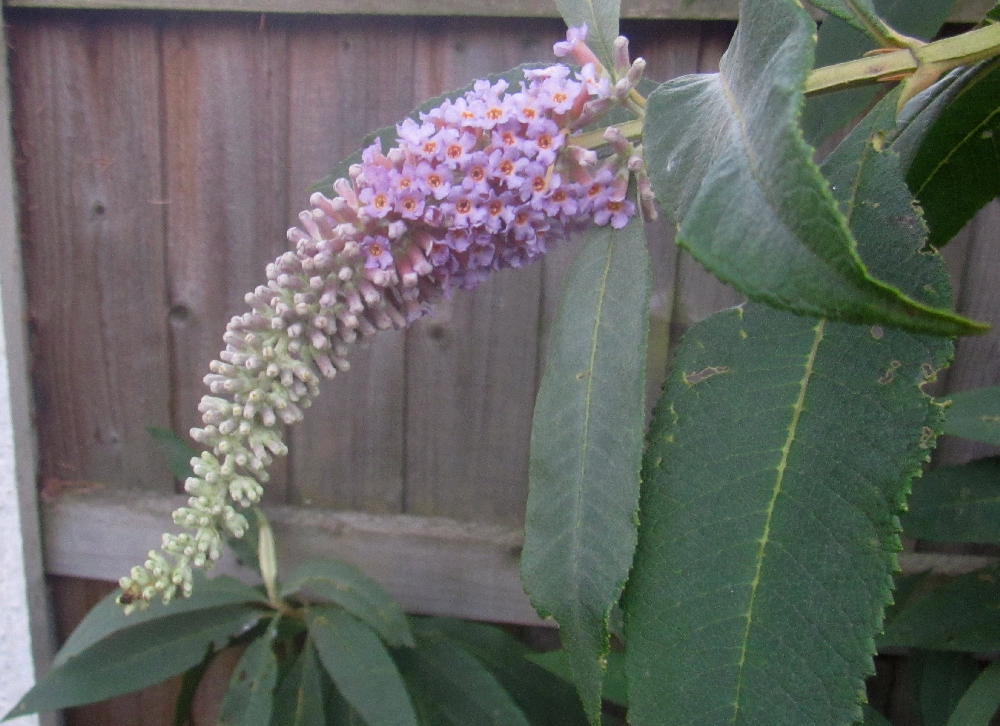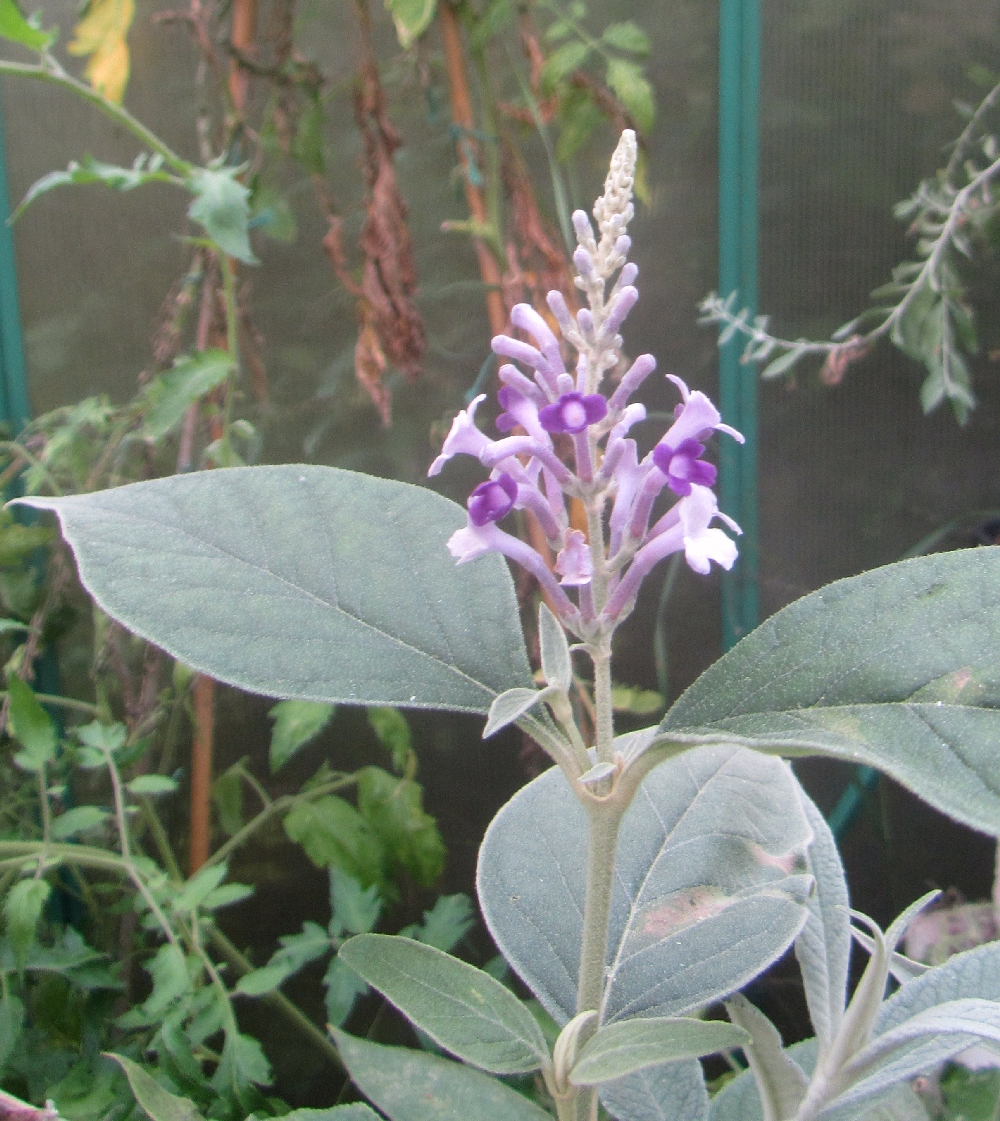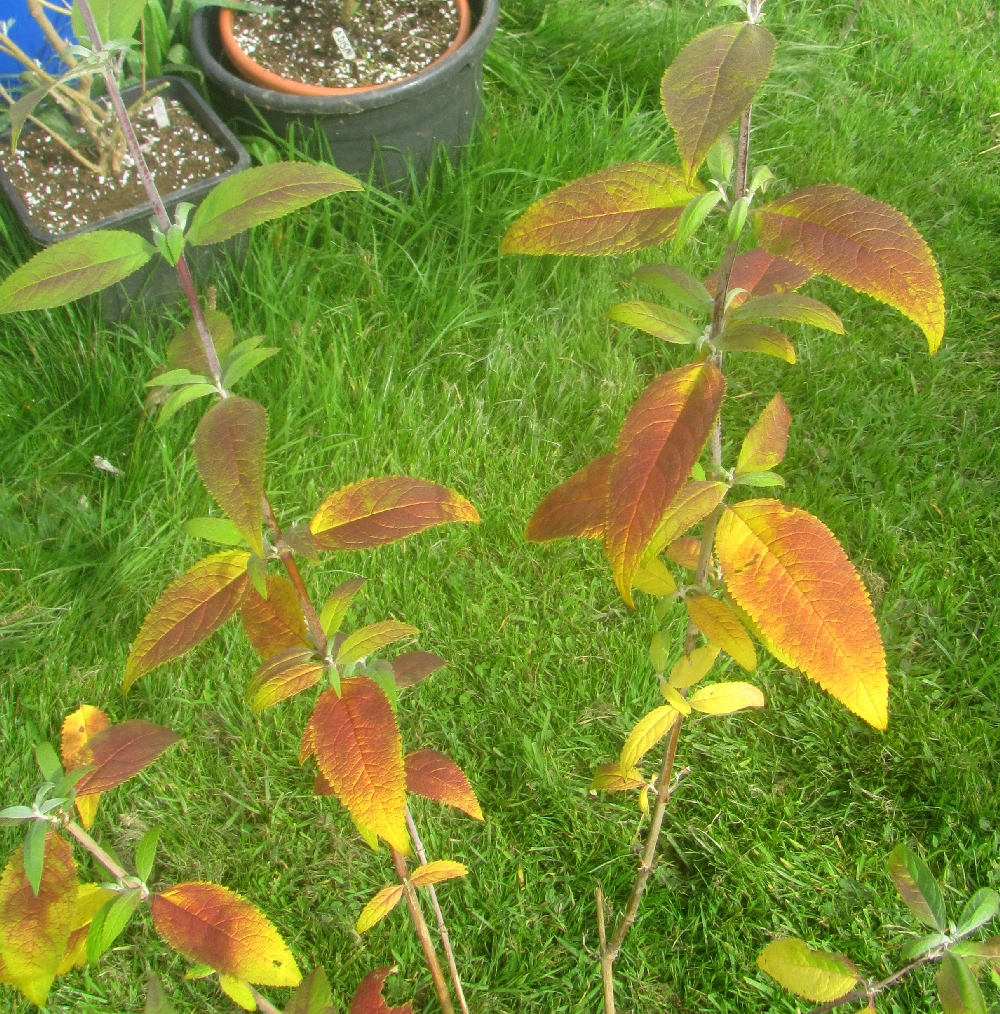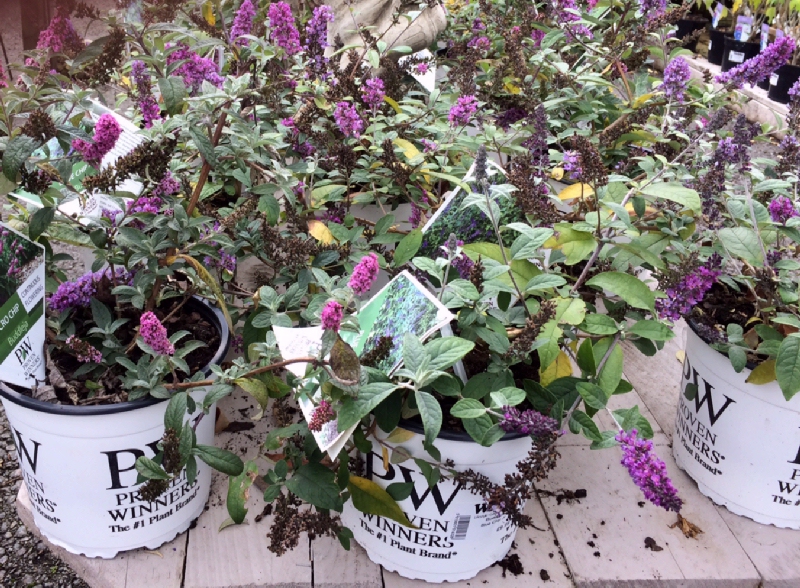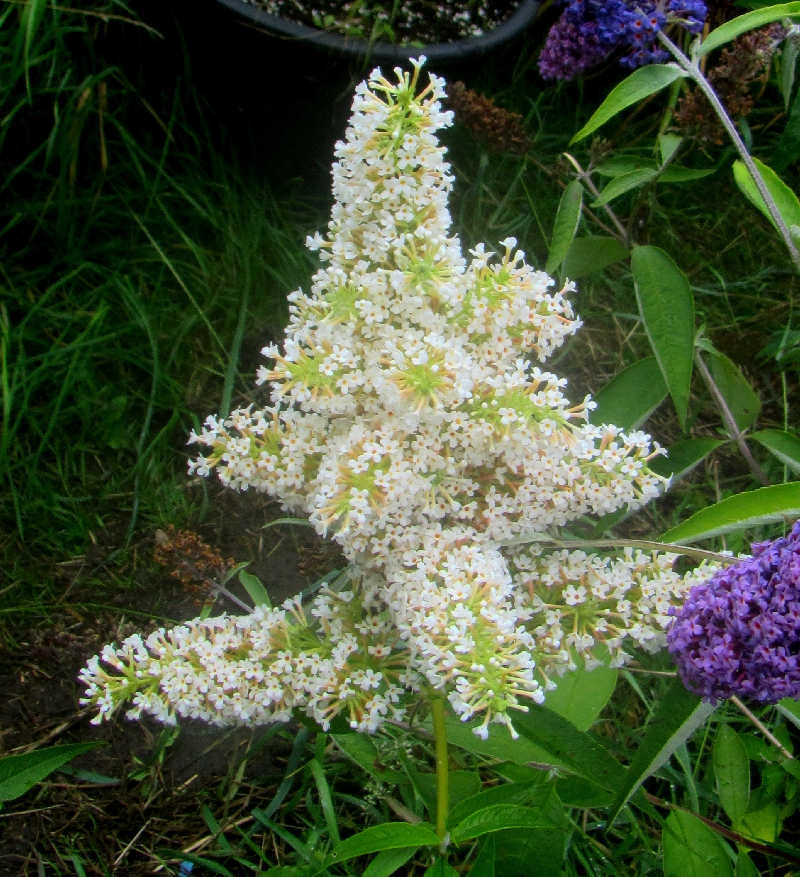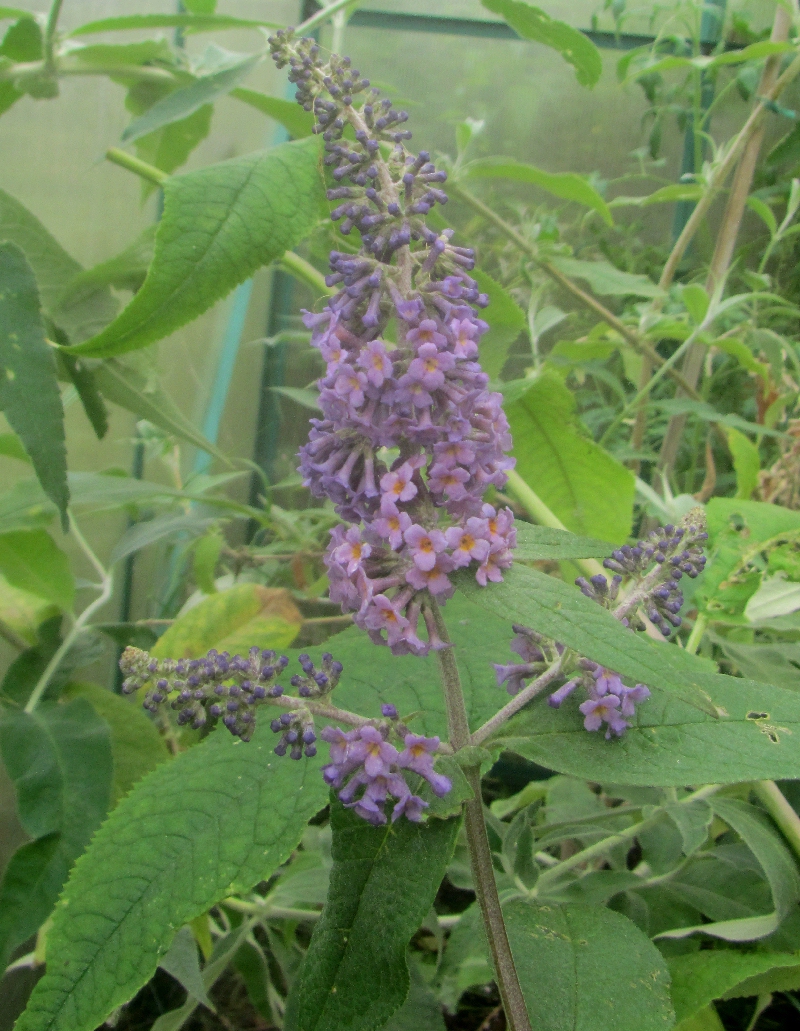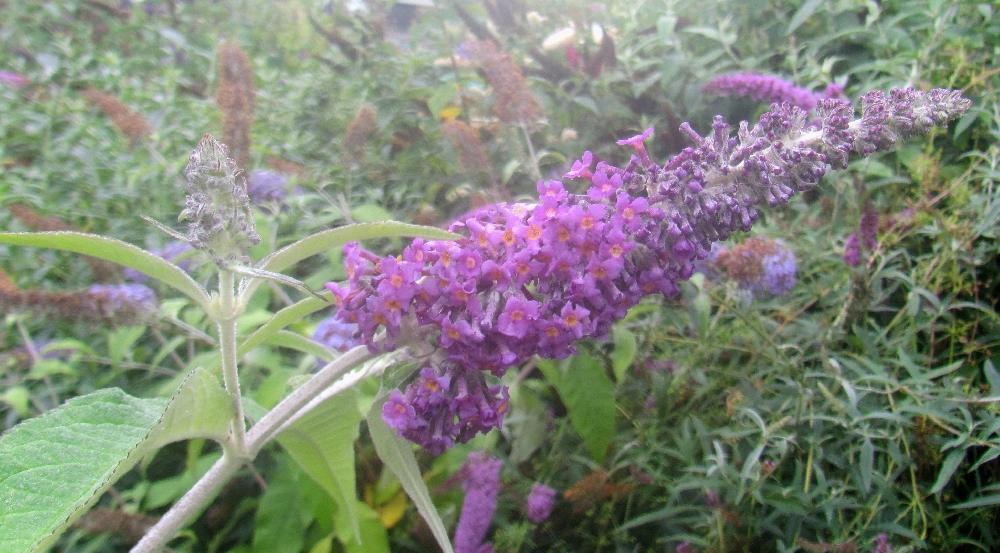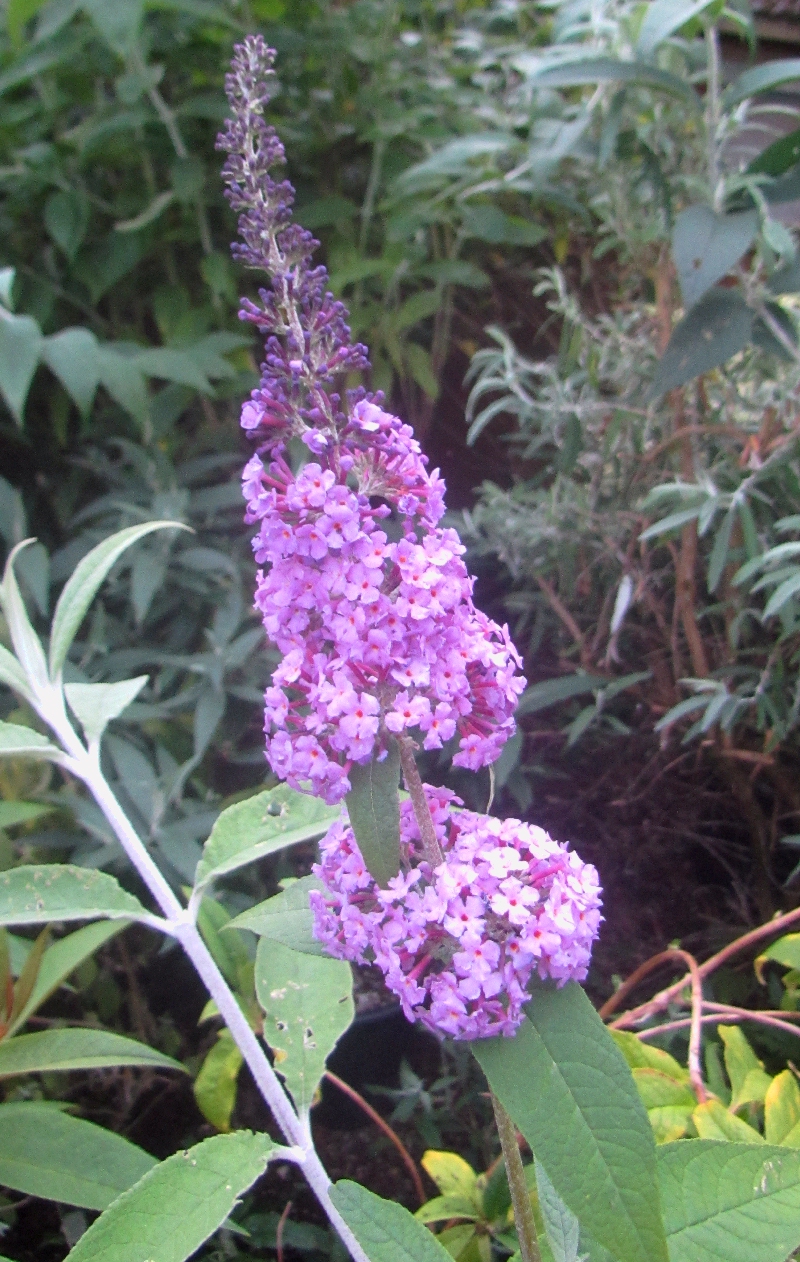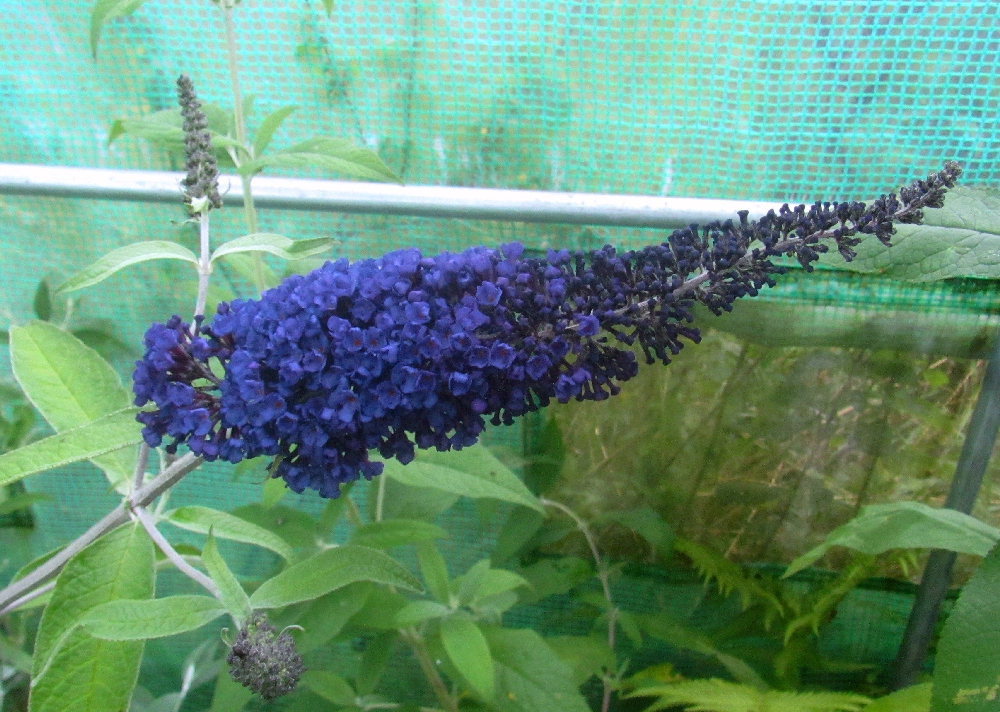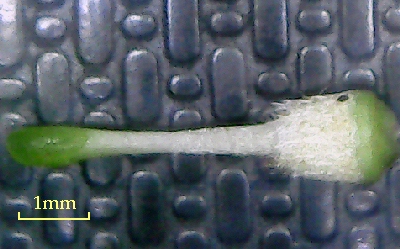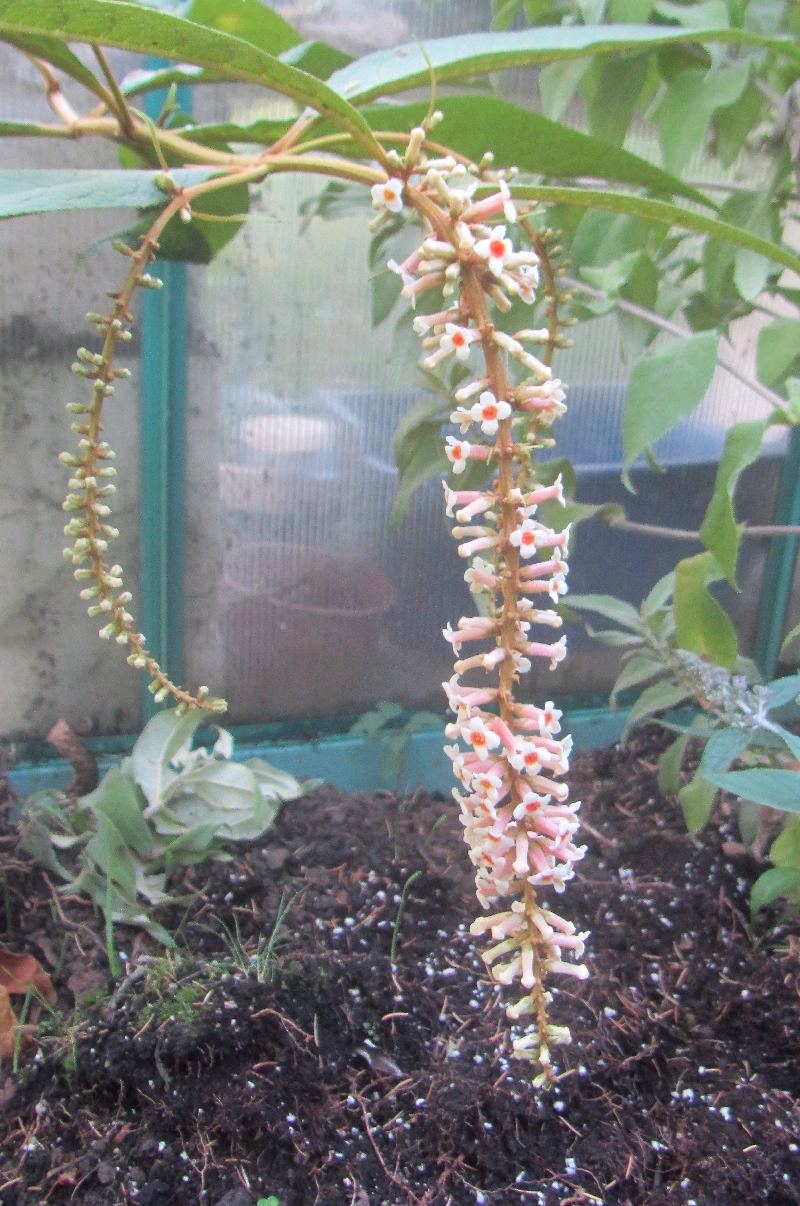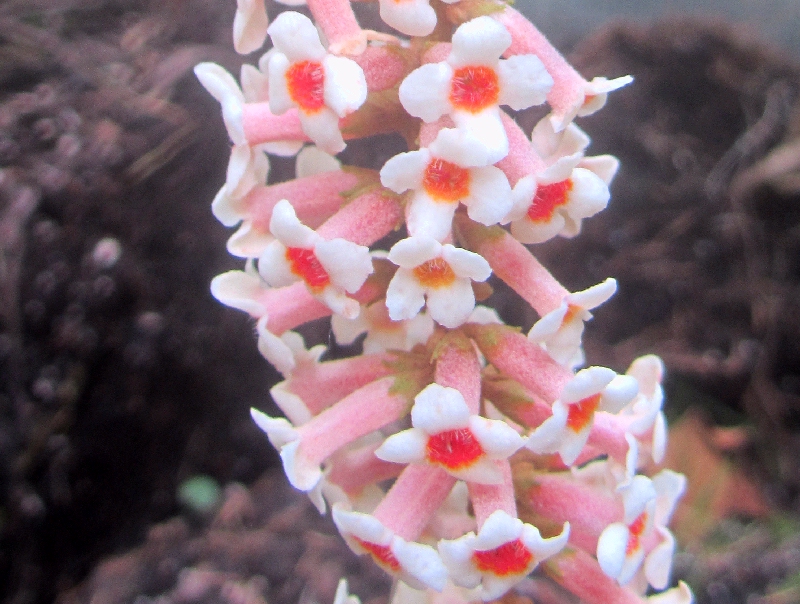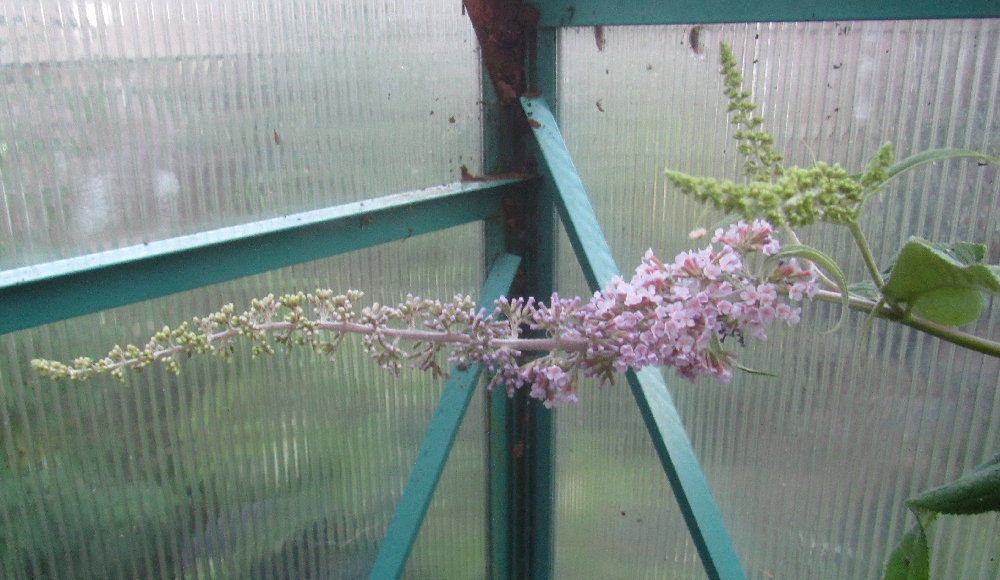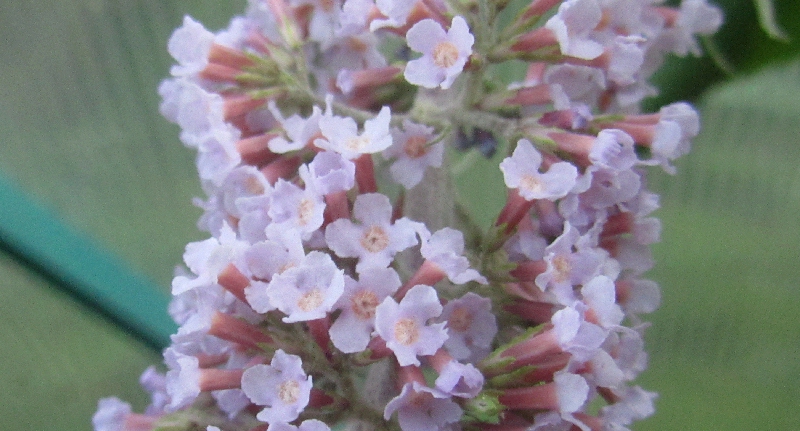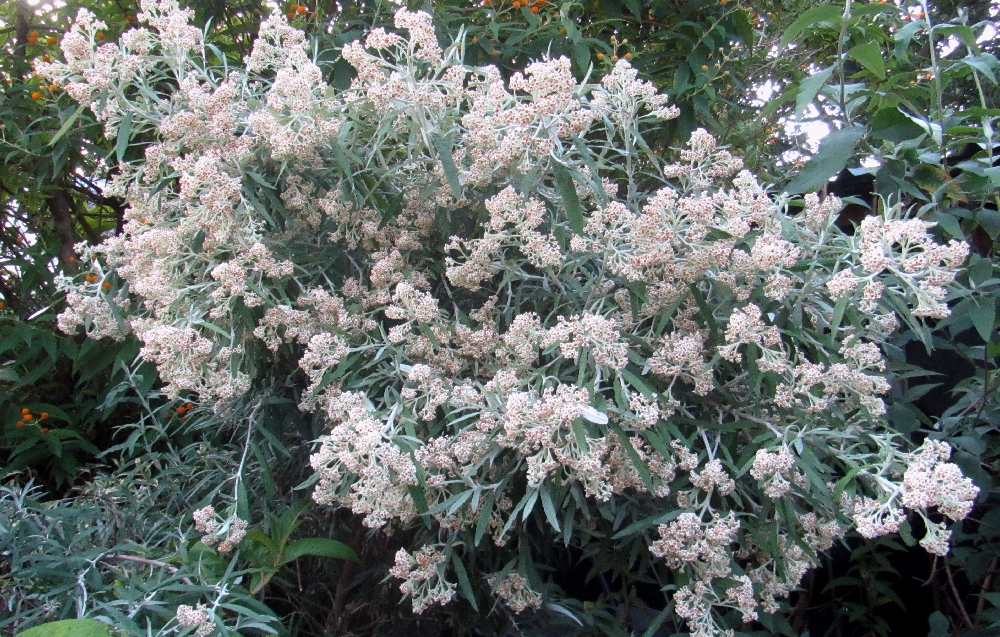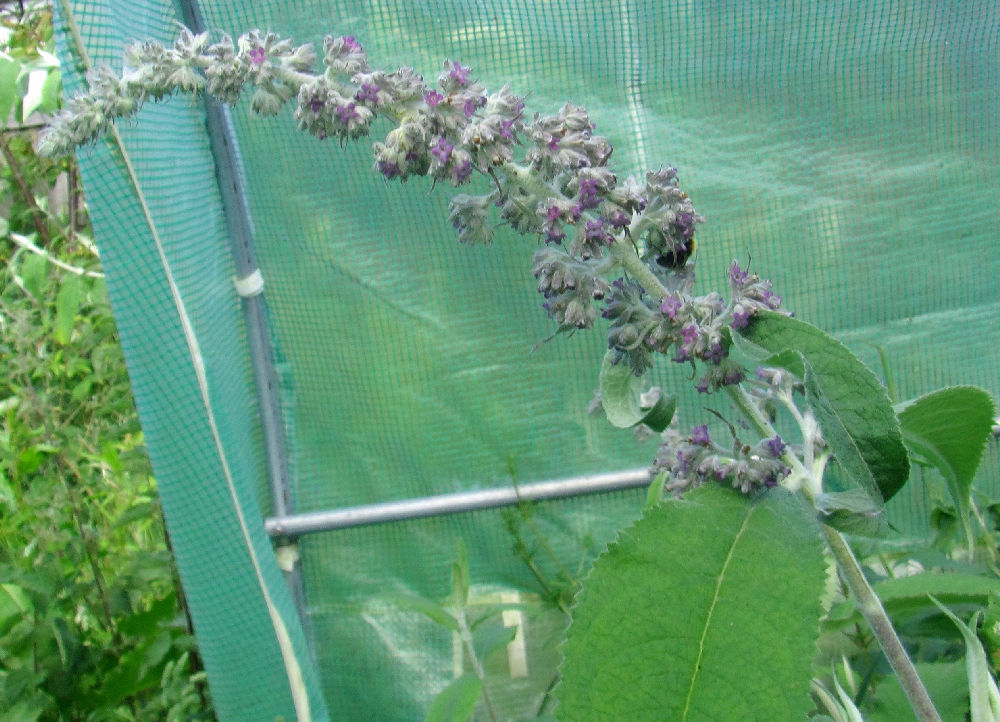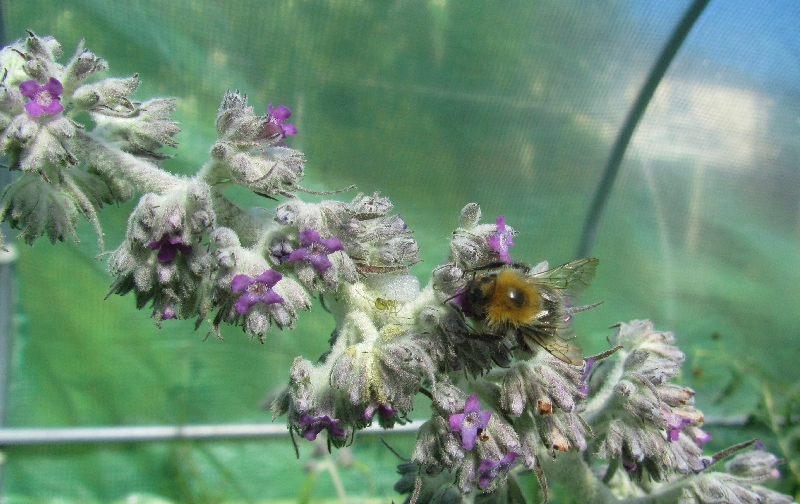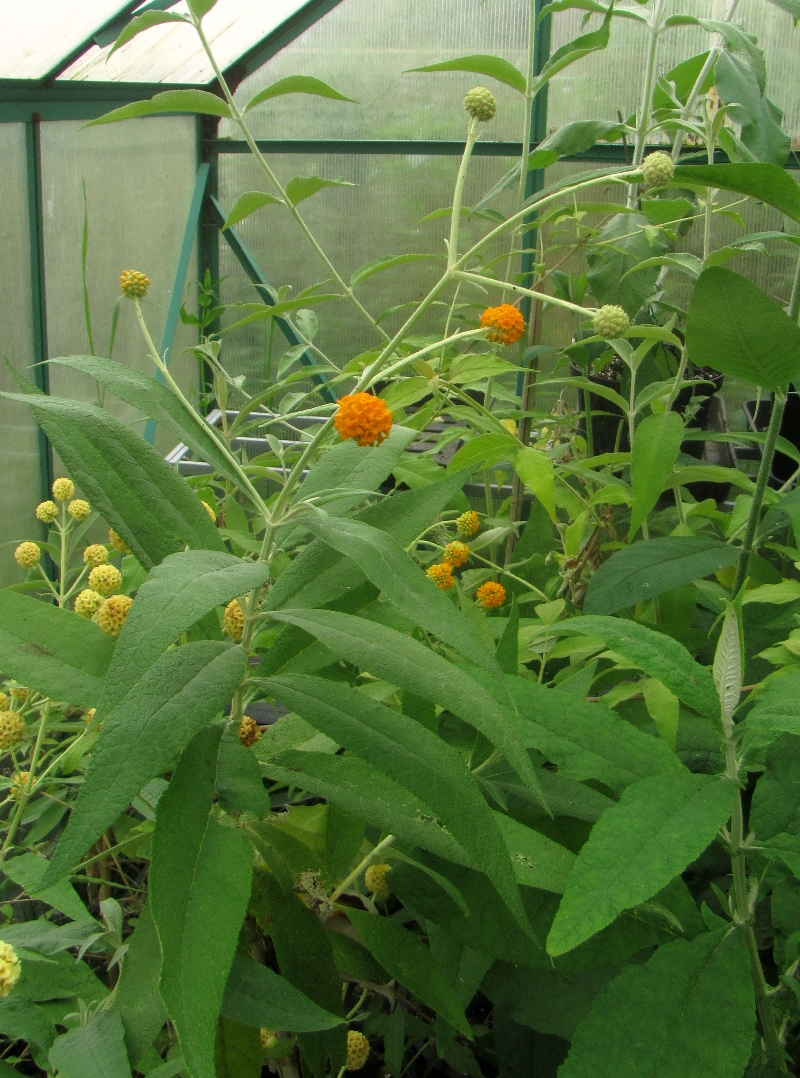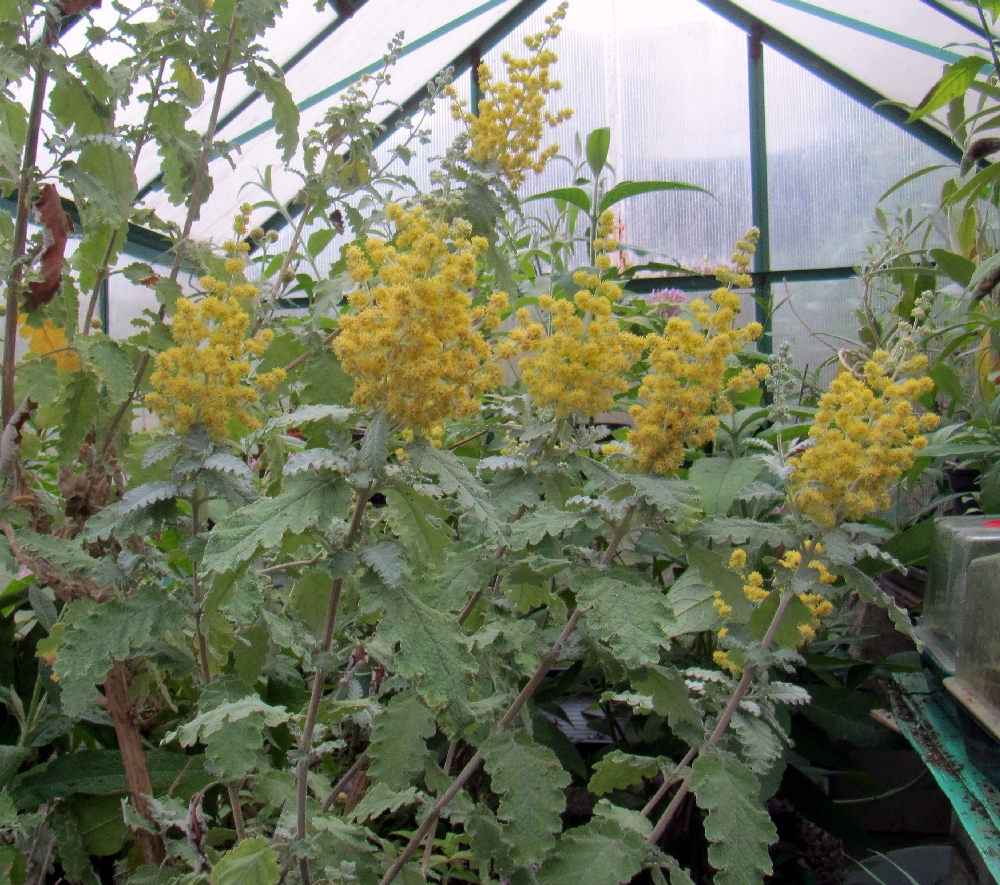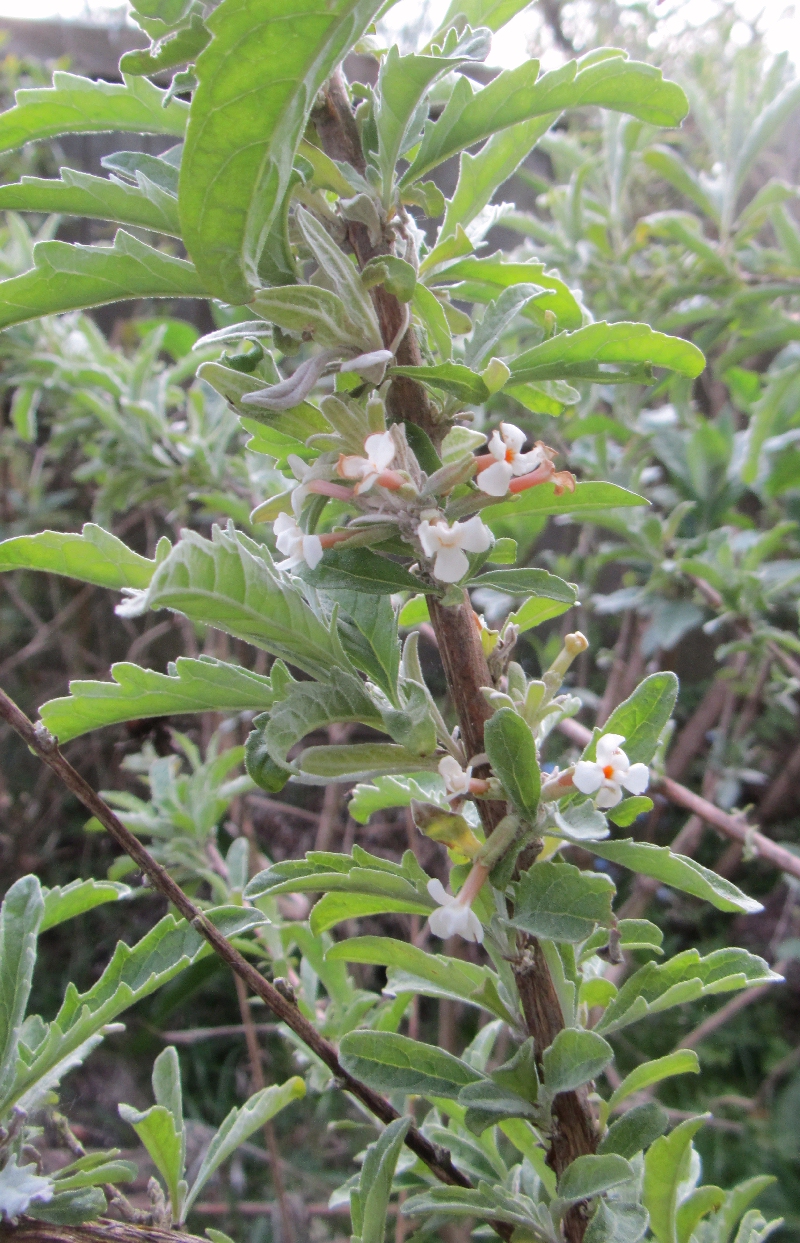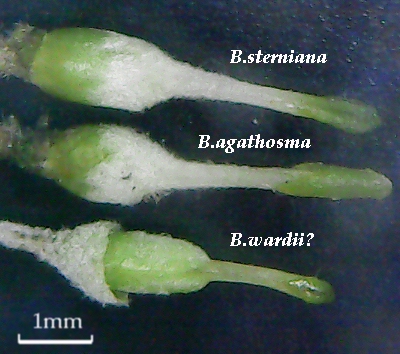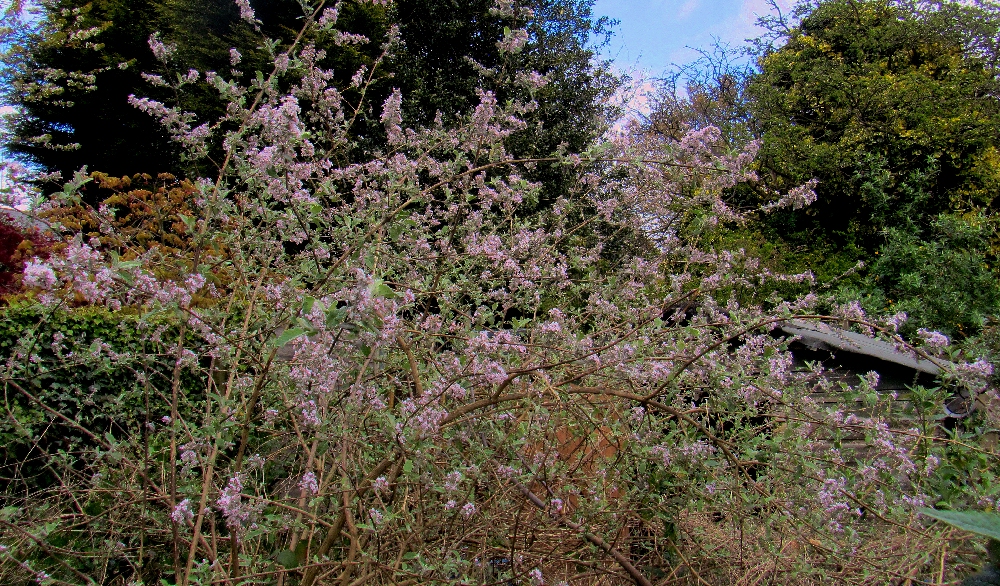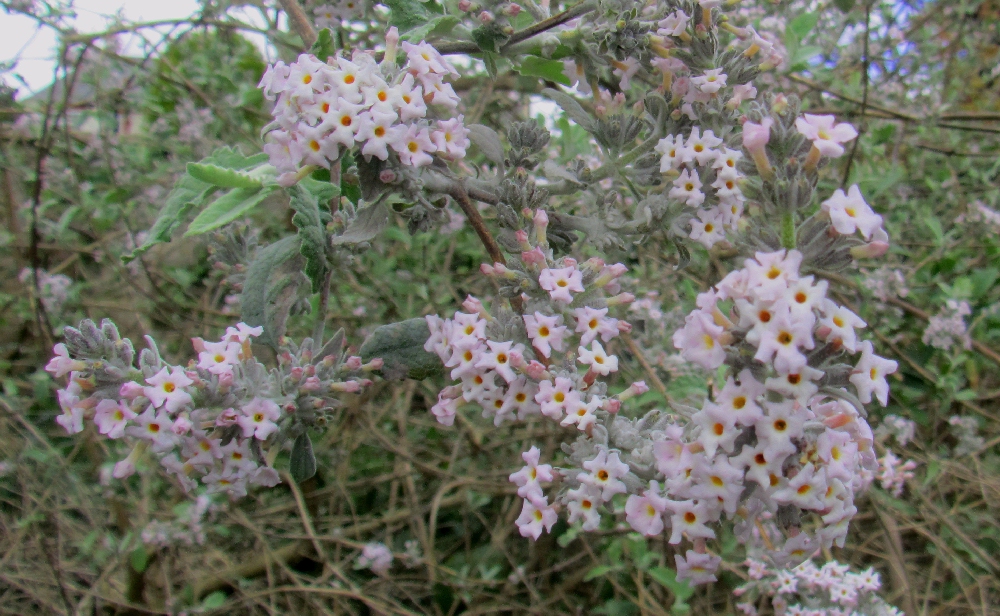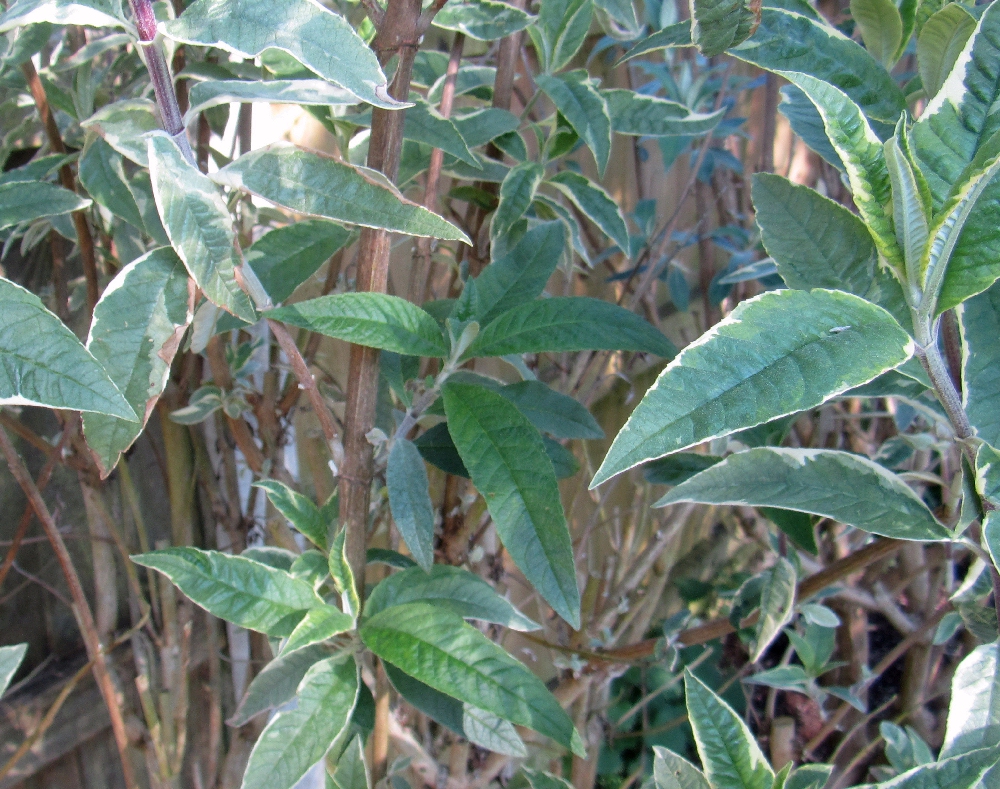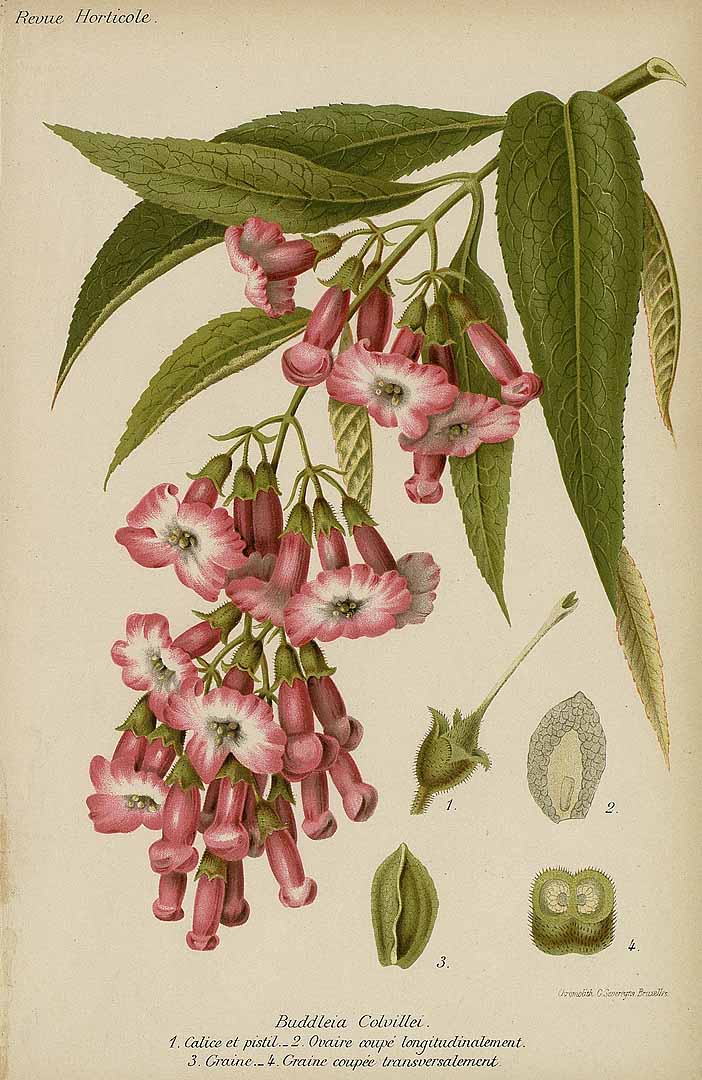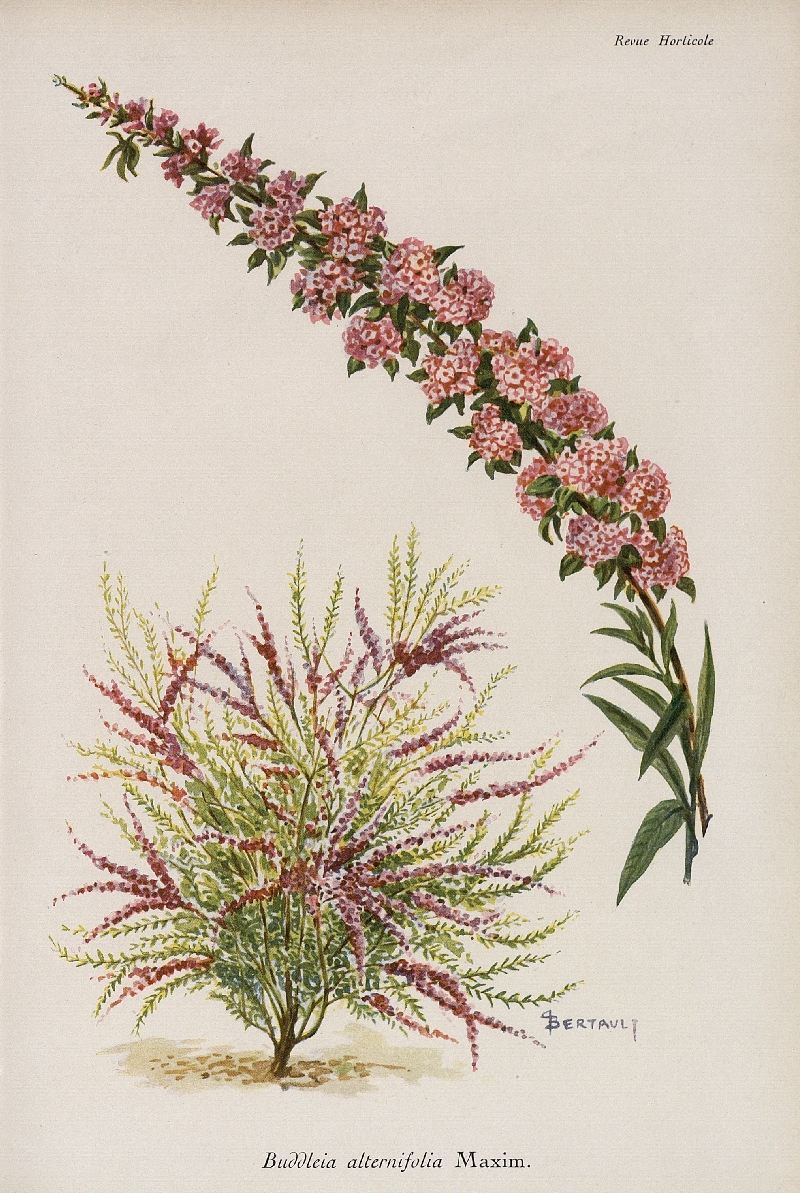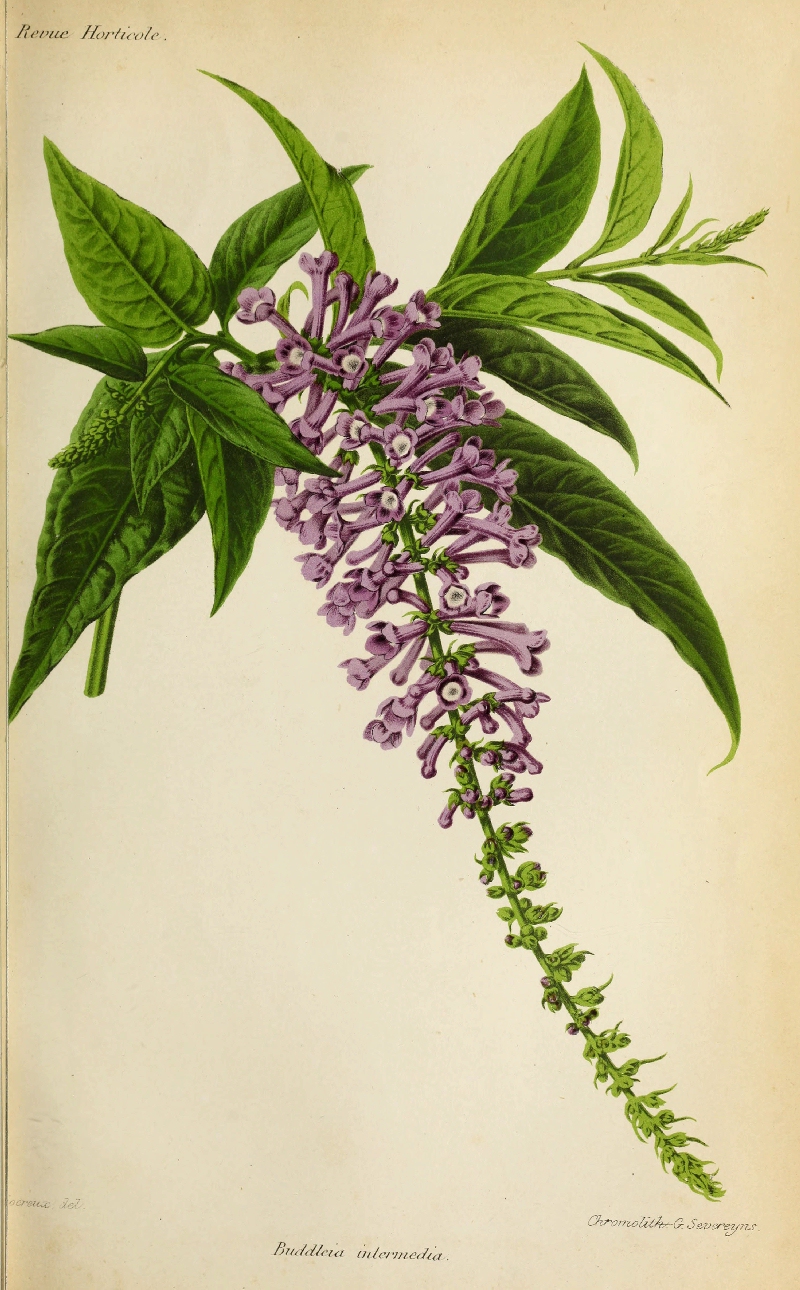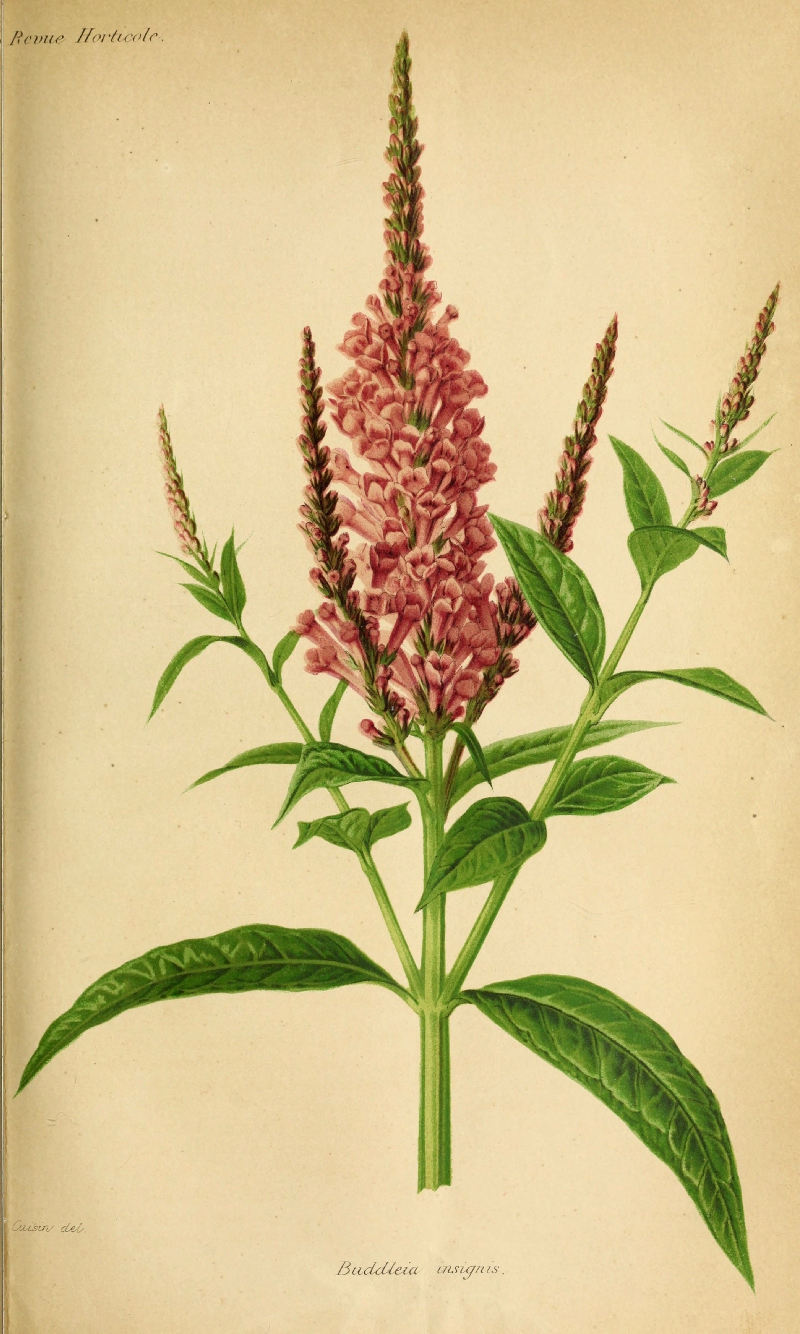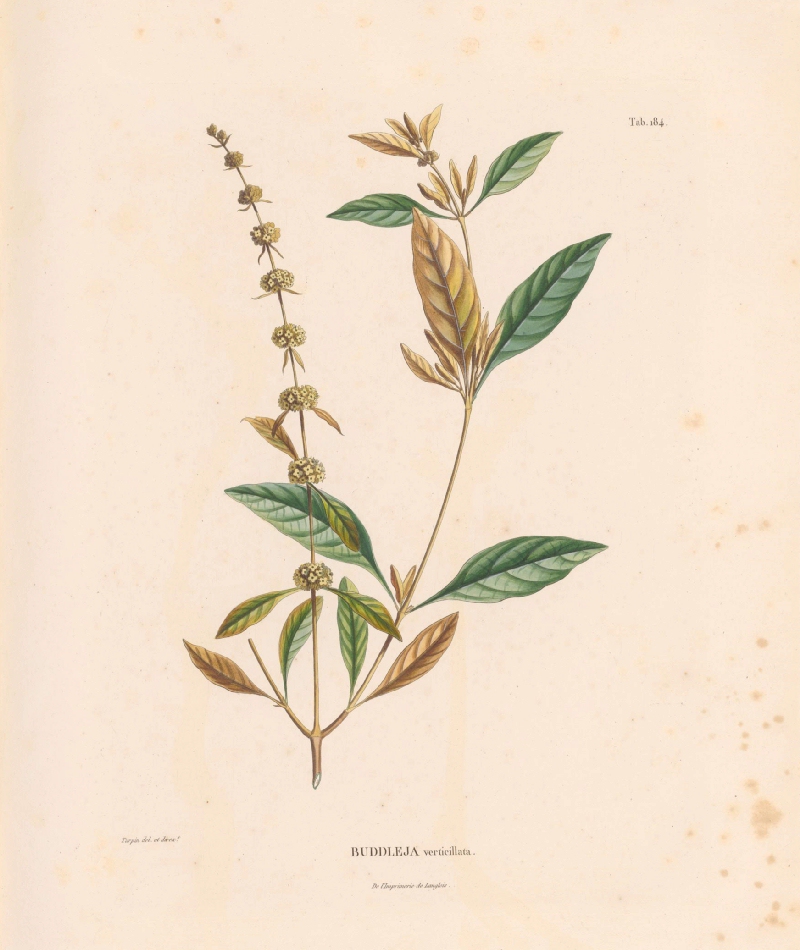
Buddleja
Navigation
E-Mail:
 | |
Click images to enlarge | |
Buddleja macrostachya PAB4198Posted 12th November 2017This has flowered, rather late in the season. It seems quite content to flower in cool conditions, even though I am unsure of its hardiness. It's a big plant, almost a small tree, too big to get back into my greenhouse. It will have to take its chances outside this winter, although I'll put the pot into a larger pot and pack the space with buddle-wrap to prevent the compost from freezing. I have allocated it a space and next spring it will be planted out in a sheltered spot. Here's hoping it prove completely hardy once established. | |
|
| |
The Phantom Misnamer Strikes Again!Posted 25th September 2017I recently bought this rather attractive plant from a very reputable nursery. The flowers are interesting, opening purple and fading to almost white, with a long conspicuously curved corolla tube; the foliage is good too, and it goes red in the autumn. It's B.curviflora, a plant I am keen to grow, even if the hardiness is suspect. However, this and similar plants are often labelled as B.myriantha… A quick inspection of Flora of China (click for an illustration) would tell one B.myriantha most closely resembles B.albiflora, the former being distinguished mostly by the hairy exterior to the flowers and the fuller flower panicle. I have seen photographs of B.myriantha in its native range in China which also suggest a closer relationship with B.albiflora than with the Curvifloræ-type species. So many species Buddleja are currently being sold under the wrong names, it must surely be time for the trade to agree to a reassessment and updating of their labelling. | |
|
| |
Autumn ColourPosted 24th September 2017The foliage of Buddlejas is usually a secondary concern. True, there are variegated sports and B.fallowiana hybrids with glaucous leaves, but no dark-purple foliage or varieties selected for autumn colour as you might find with, for example, Japanese Acers. This little Buddleja seedling surprised me with the spectacular colours – golds, russets and reds – in its leaves, a phenomenon I have not really seen in any other Buddleja, other than maybe a little reddening. The flowers were a common mauve; even so, I am saving this plant to see if it will repeat this autumn show. Unlikely, as it could be an artefact of being pot grown or specific weather conditions; I won't know until this time next year. | |
|
| |
Buddleja and ChipsPosted 11th September 2017I came across this rather sad display in a garden centre last week, a mixture of Pink Micro Chip and Blue Chip Junior. I haven't grown these two yet, but I have found Blue, White and Lilac Chip to be very disappointing. I can't see any reason to believe these new Chips will be any better. There is no point producing miniature Buddleja if their flowers are tiny and the plants are ugly. Many new hybrids are being rushed to market as novelties, and are not proving to be particularly good garden plants. Of course, if they routinely look so poor in the garden centres, no one will be buying them anyway. | |
|
| |
A Different Flower TypePosted 15th August 2017Multi-headed flowers are surprising common in B.davidii: Dartmoor, Greenways River Dart, Panache, to name three with this flower type. A few years ago I found a feral white Buddleja with this flower type; I called it Snowmageddon and, although the flowers are magnificent, the habit leaves a lot to be desired - distorted foliage in the spring and yellowing leaves after flowering. So naturally I had a go at improving it. This is the result - even more branched flowers and a smaller growth habit. Sadly the new foliage still becomes twisted in the spring if touched by a cold wind, and the leaves are going a bit pale and ragged as it diverts all its energy into the flowers. Maybe I'll try another generation, but meanwhile I have called this one… Snowmageddon 2: The Snowpocalypse. | |
|
| |
More HybridsPosted 12th August 2017I can't resist keeping seeds from the species Buddlejas I grow. Sometimes I try specific crosses, sometimes I just leave the bees to decide what happens - and the promiscuity of the Asian species means hydrids abound, even when there is a ploidy (number of sets of chromosomes) mismatch. These two plants are the result of open-pollination and, although I know the seed parent, I have to speculate as to the origin of the pollen. Buddleja limitanea is a type of B.forrestii and is hexaploid. I have crossed it with B.nivea and B.albiflora hybrids, but this one pictured is the first one I have found which is likely a hybrid with B.davidii. It is not a particularly good colour and rather leggy, but could be useful in creating further hybrids. The second hybrid shown (lower right) is most probably a cross between B.nivea and B.davidii, again species of differing ploidies. This one's flowers are a much brighter purple and have a large orange eye, which adds to the effect. Unlike other B.nivea hybrids I have grown, this one has small leaves; the downside is that it is also less furry than the others. The questions waiting to be answered is whether they are fertile, and which plants are they most likely to cross with. Conventional wisdom suggests the two plants shown are pentaploid, and could be producing 2n and/or 3n (n=19) gametes. From what I have seen so far, similar plants are producing viable seed, and hybrids combining three, four, even five species are possible. I am hoping these two will be compatible with my other hydrids, or can be back-crossed to one of the original species. | |
|
| |
From the WildPosted 9th August 2017As well as the B.albiflora seeds, which have grown into plants distinct from the specimen held in the National Collections, I also received some B.davidii seeds originating from Chongqing, central China. And the seedlings from these are now flowering too. They are a very varied bunch, with colours ranging from dark mauve through to palest lilac, and the inflorescences differ in form somewhat too. The seeds are from a single location and this level of variability goes a long way to explain why the original species names was B. variabilis. The one pictured is the most attractive, a delicate lilac-mauve and a pleasing flower shape; the two balls of flowers at the base are reminiscent of the cultivar Gonglepod, although this plant is much more upright. In general, the internodes (stem between the leaves) are longer than cultivated varieties as they have never been selected for a restricted growth habit. However, they are not distinguishable from the weeds that litter urban waste-ground; the species has changed little in its fifty or so generations during which it has colonised the UK, and artificial selection for garden-friendly Buddleja has had little impact on the UK feral gene-pool. Though occasionally a feral Buddleja will offer a surprise: the blue seedling below was bred from a very poor feral plant: weak, straggly and with a tiny flower, although one extraordinarily dark. So what curiosities might be lurking in the Chinese wild? | |
|
| |
Deep Blue BuddlejaPosted 6th August 2017This new flower just opened. I was struck by the navy blue, and also by how deep and inky the colour appeared compared to the other blue Buddleja vairieties. Looking closely I can see the central orange eye, a common feature in most Buddlejas, is greatly reduced. This makes the overall colour very dark because the effect is not disrupted by a contrasting centre. Some flowers, like Miss Ruby for example, have a very bright eye; although this makes the flower brighter from a distance, it does also detract from the intensity of the colour. | |
|
| |
Buddleja forrestii…
| |
|
| |
Buddleja albifloraPosted 30th July 2017Last year I obtained Buddleja seeds from Chongqing, central China; I didn't know what species they came from, but I grew them anyway. The first batch have started flowering and the plants can be readily identified as B.albiflora. The plants are quite variable. The first one (top right) is much like the widely available cultivar of B. albiflora, except the leaves are longer and flower colour is somewhat darker - although the flowers of this species are rarely white despite the name! (Note: the big leaves in the background are from B.forrestii.) The second one has a much more attractive flower - pink, and the panicle is full rather than interrupted and open. As the seeds came from a region shared with B.davidii, and the two species readily hybridise despite the ploidy (chromosome number) mismatch, I had to consider whether the plant is a hybrid. I have grown many hybrids of the two species; examining the flowers closely and comparing them to the hybrids, the B. albiflora X B. davidii hybrids have fewer hairs in the mouth of the corolla tube, whereas in species B.albiflora the hairs completely fill the opening. Another feature which helps identifies plants as B.albiflora is very rounded (terete) stems, whereas B.davidii have more squared (tetragonal) stems. I have also grown some B.davidii from seed originating in the same region, and these too are about to flower. It will interesting to compare these authentic plants from the species's native habitat with the garden cultivars and the feral Buddlejas that have colonised the UK. | 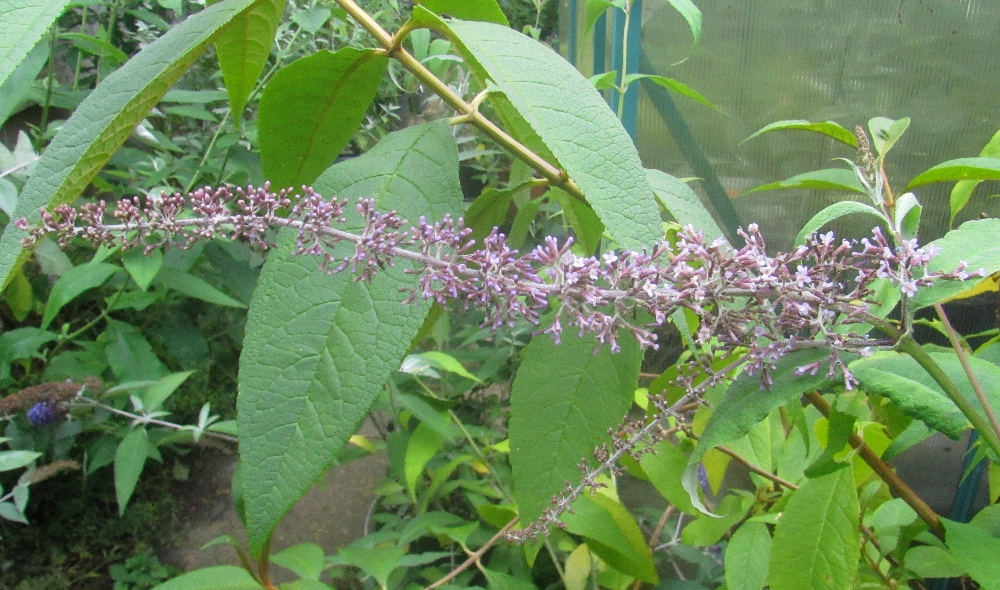
|
|
| |
Buddleja limitaneaPosted 17th July 2017B.limitanea is a smaller version of the vigorous B. forrestii, and many consider them to belong to the same species. There are, to my knowledge, at least four cultivars of B. limitanea currently in the UK. This one, grown fom seed recently collected in Yunnan (China), comes via Brighton Plants, and is a very pretty pink, rather than the more usual muted mauve-purple. It should be reasonably hardy, being from 3300 metres elevation. | 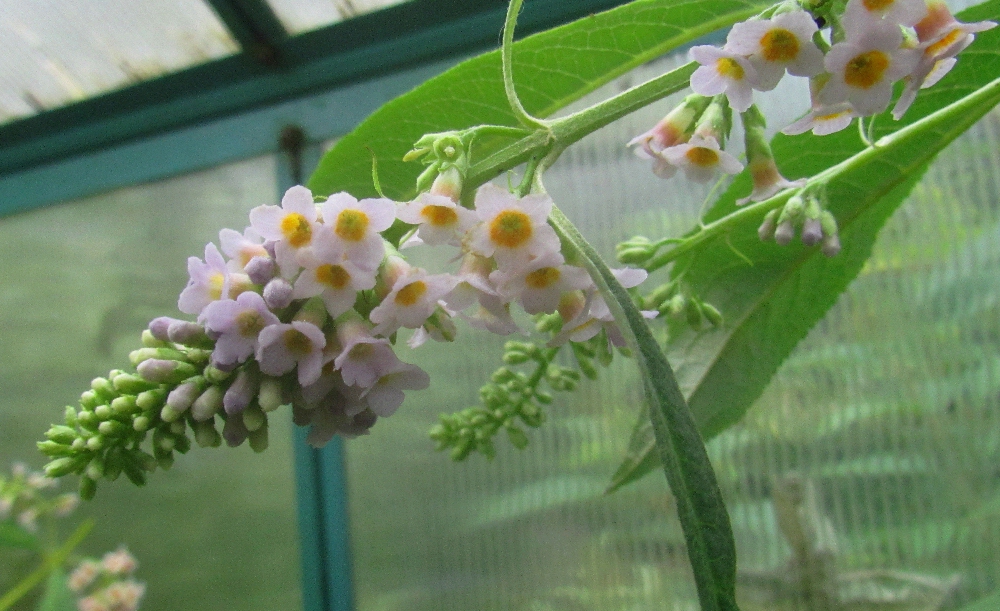
|
|
| |
B. davidii Nanho BluePosted 7th July 2017Sometimes we can get obsessed by the new, and forget about some of the old cultivars. Nanho Blue (syn. Mongo) is one of the oldest varieties and is out of favour, losing its RHS AGM in 2010. I recently started a new plant from a cutting and it has reminded what an attractive plant it can be, with its long, blue flowers and its small, narrow and dark foliage. However, it is one that can get straggly and sparse if not correctly pruned and fed. | 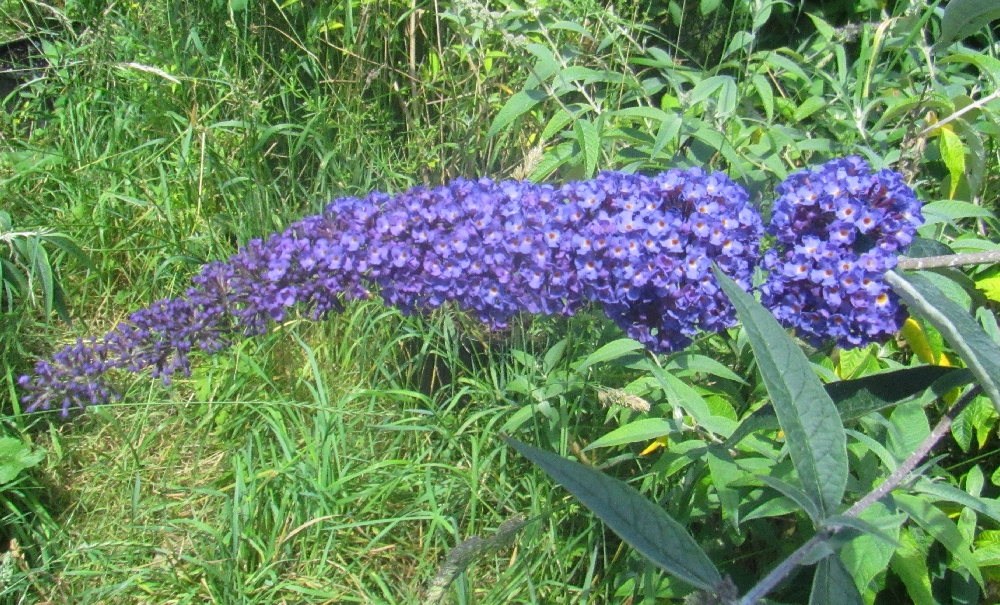
|
|
| |
Buddleja loricataPosted 22nd June 2017B. loricata, also called Mountain Sagewood in its native South Africa, is an underrated Buddleja and more people should grow it. Fully hardy, evergreen and an excellent foliage plant, the flowers are a bonus. Usually appearing in June, the white flowers are in corymbs rather than panicles and are a little different from the more familiar members of the genus. My own plant has grown rather unruly, but has flowered to an extent I have not seen before, completly covered in white inflorescences like clouds - and a fantastic citrus/spicey scent on warm days. Sadly, the flowers have just finished and it is due for a rather severe pruning. By pruning now rather then the autumn it should have time to put out new growth before the winter - I must remember to mulch and feed to ensure it has the nutrients needed to regrow vigorously - and be ready to produce another stunning display next June. | 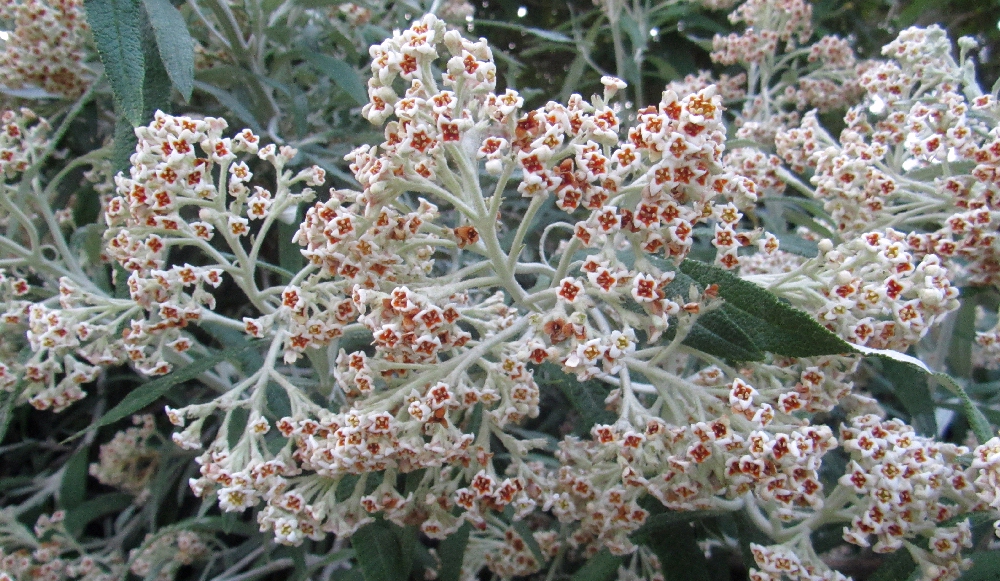
|
|
| |
Buddleja nivea
| 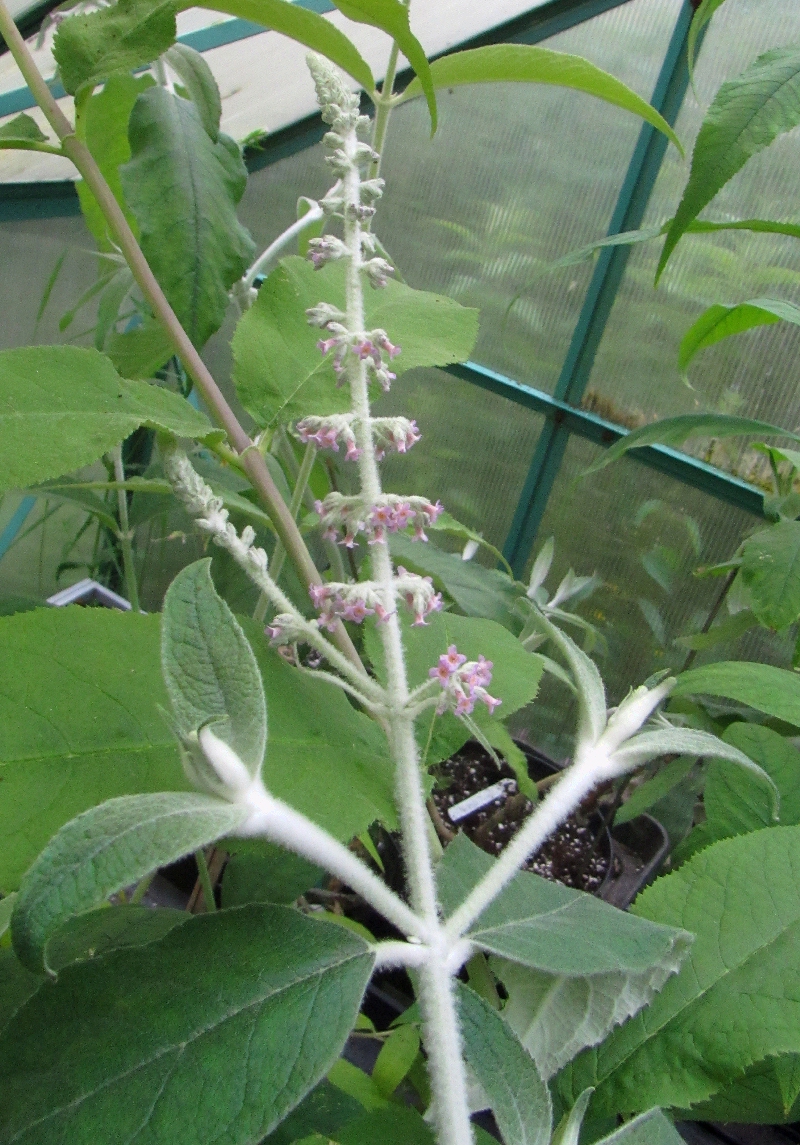
|
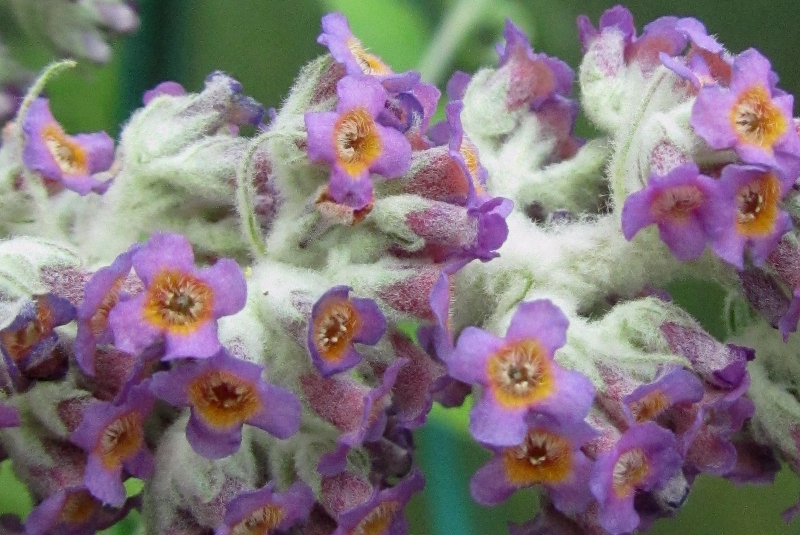
The more common purple B. nivea. | 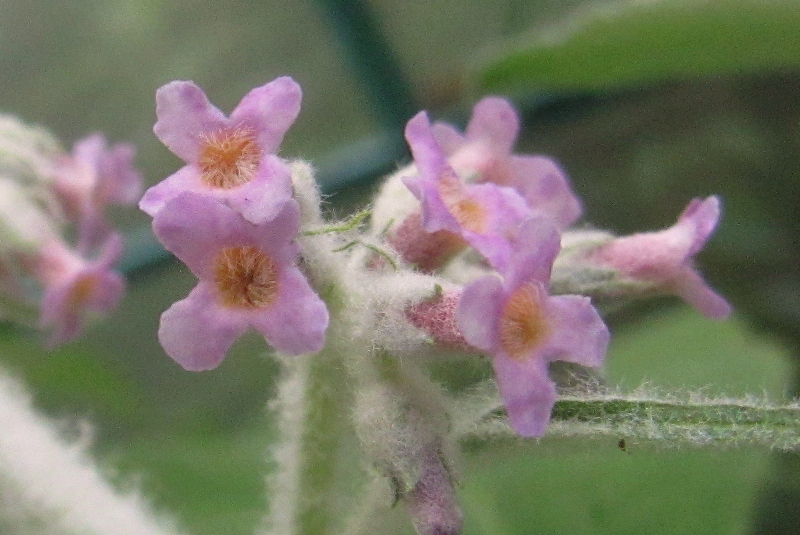
The pink form of B. nivea |
|
| |
Buddleja nivea var. yunnanensisPosted 7th June 2017Buddleja nivea is a very variable species and several types are in cultivation, including this one from Yunnan in China. The Yunnanensis variety is much larger in size than the species type, easily reaching four metres or more in height; a doubling of its chromosome number possibly accounts for its size and vigour. It's quite common in culitvation and is mostly grown for its dramatic large, furry and serated leaves. Although hardy, the foliage is vulnerable to very cold or strong winds, so its not suited to an exposed site. Given it's a large Buddleja with exciting foliage, the flowers are something of a disappointment. The individual flowers themselves are pretty much the same as the species type - purple, short corolla tube with a hairy throat - and the panicles are long, but the flowers don't open in strict sequence along the inflorescence; a few open and here and there and never provide a rich display of colour. This doesn't seem to matter to pollinators and the flowers are still a bee magnet. | |
|
| |
Buddleja globosa X Buddleja araucana HybridPosted 31st May 2017I asked myself the question why so few people had tried to breed a better B. globosa. The answer, it seems, is that the seedlings are fiddly to grow and you have to wait several years to get flowers. And then everything comes out orange. A couple of years ago I crossed B. globosa with B. araucana, formerly B.nappii, a closely related species with brighter flowers. Finally, a couple of the seedlings have flowered… orange. The hybrids are almost perfect intermediates between the parent species. The longer, narrower leaves and fuzzy stems are inherited from B. araucana; in the photo the leaves can be compared to the B. globosa foliage in the bottom right-hand corner. The two seedling that have flowered (so far) are different sexes - in the female (see below) flower the stamens are completely absent, whereas the male has evident white stamens shedding pollen (below right). Every male seedling I have raised from my female B. globosa has these obvious pale stamens, although the common male B. globosa cultivar has more orangey-brown stamens. I'm also growing the progeny of Lemon Ball, a distinct B. globosa female cultivar with lighter orange flowers, and I am hoping the resulting males won't have such bright stamens, although I will have to wait until next year for these to flower. |
|
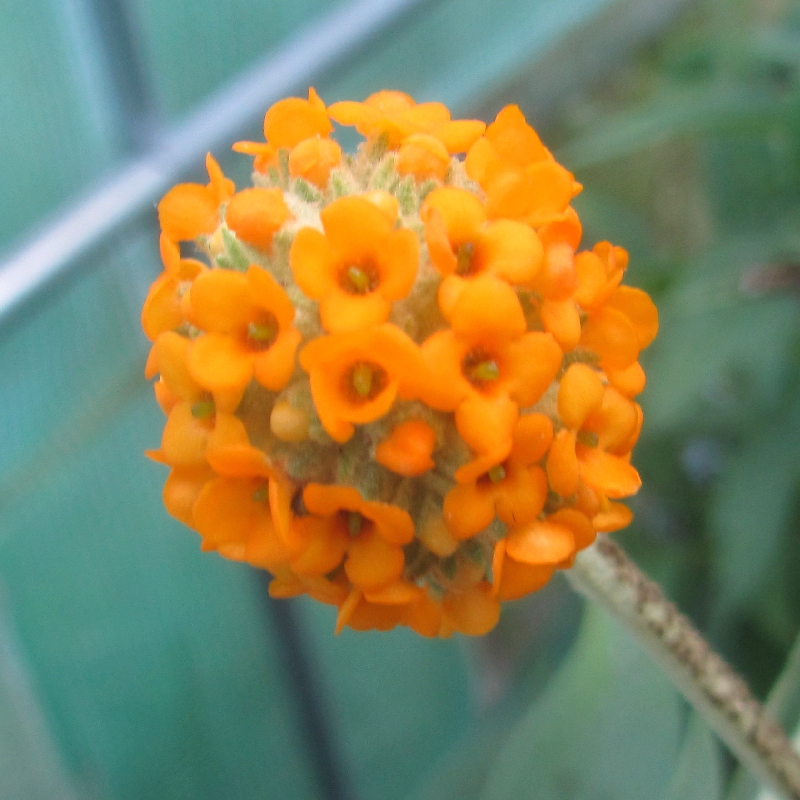
The female hybrid, note the lack of stamens. | 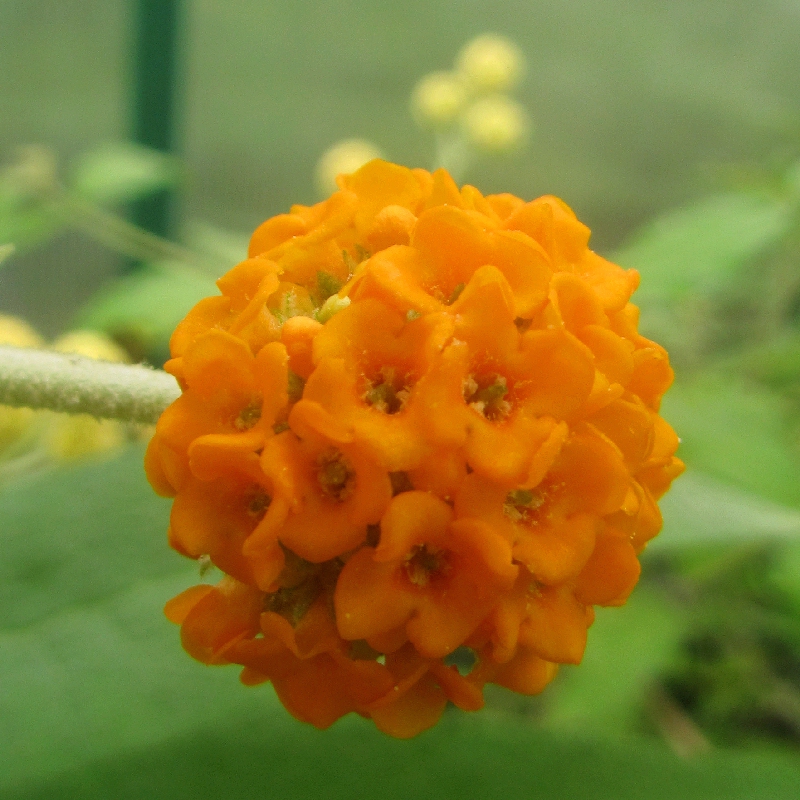
The male hybrid, note the white stamens shedding pollen. |
|
| |
Buddleja glomerataPosted 19th may 2017B. glomerata is a plant I would not grow outside because it needs dryish condition. This presents a problem, as the plant can soon become potbound; then it flowers less and looks unhappy. The answer is to not just prune the top growth, but to trim the roots too. Last summer I knocked it out its 15 litre pot, took off any congested roots and, returning it to the same pot, replaced about half the contents with fresh compost mixed with a little slow release fertiliser. And this is the result the next spring - a happy plant covered in fuzzy flowers. It is trick I have used with a few a Buddlejas now. The alternative is to have all the tender Buddlejas in 100 litre pots, which is rather impractical in a tiny greenhouse. | |
|
| |
Buddleja x wardii KR4881Posted 9th may 2017On the My Species page I took the bold step of applying my own identification and name to this plant, believing it to be a white-flowered form of B. alternifolia previously known as B. tsetangensis. I have waited a year to closely examine the flowers; although a healthy plant with very attractive foliage, it's extrememly parsimonious with its flowers when grown outside. B.X wardii is considered a natural hybrid (or intermediate) of B. alternifolia and B. crispa; the original specimens were collected in Tsang-po valley (Tibet), a region where both species grow, and close to where the only known specimen of B. tsetangensis was collected. Dissecting the flowers has convinced me KR4881 is not a hybrid of B. crispa, and hence is not B.X wardii. In the photo the ovaries of two Buddleja crispa types (plants of this species still frequently labelled as B. sterniana and B. agathosma) have been freed of the corolla and calyx, and are shown together with a dissected flower from KR4881. The difference in shape is striking, with the KR4881 ovary, style and stigma (gynœcium or female parts) being completely unlike either of the B. crispa examples. According to the literature, the female parts of B.X wardii should resemble those of B. crispa, with thick tomentum covering the upper half of the ovary and continuing onto the style. In KR4881 not only is the ovary shape and size very different, but the tomentum is sparse and restricted to the ovary; all its features are much more akin to those found in the flowers of B. alternifolia, and not intermediate between the two species. I also examined the flowers of "Longstock Gem", an artificial hybrid of B. alternifolia and B. crispa, and the gynœcium of this plant is almost identical to that of B. crispa. I am pretty certain the plant should be labelled B. aff. alternifolia KR4881; B. tsetangensis has been reduced to a synonym of B. alternifolia and should no longer be used. To return to the B crispa types, it is quite remarkable how different the two plants mentioned appear to be, with the leaves and corolla of B. agathosma four or more times the size of those of B. sterniana, yet the gynœcium scale and morphology are virtually identical, providing good evidence they should be included in the same species. | |
|
| |
Buddleja sternianaPosted 14th April 2017Things are starting up in The Buddleja Garden at last. This past winter has been very mild indeed and has meant stalled flowers buds have survived. Many of the spring-flowering species and hybrids are beginning to open now, such as the Crispa Complex species B. agathosma and B. sterniana. Winter Sun, a hybrid of B. araucana has also flowered very well. My B. sterniana was planted out a few years ago and didn't appear to do much at first. Orginally, I kept the plant in a pot where it stayed small and produced only a few weedy flowers. I was unsure whether it would prove hardy in a south-facing, but exposed, position. This year, however, it has finally exceeded my expectations; outside it has grown into a large straggly monster about 3 metres tall and 4 metres wide. The flowers, which appear before the leaves, cover the entire plant and from a distance it looks like a pale pink cloud. The plant is in for a shock - as soon as the flowers finish it is in for a rigorous pruning to tame its straggly character. It should regenerate into a denser, better shaped shrub by the autumn. | |
|
| |
The 2017 Buddleja Diary is here!Posted 8th April 2017It's time to prune Buddleja davidii - I always prune summer-flowering species and hybrids in April. There is already a page on pruning, so I won't go into details. Remember - don't prune spring-flowering species until after they have flowered. Watch out for those reverted, all green shoots on variegated cultivars such as Harlequin - like the one on the centre of the photo. Remove any branches now with reversions and keep a check once the growth restarts - the reverted shoots will be much more vigorous and could eventually take over the plant. | |
Buddleja forrestii - I have had some success with one B.forrestii planted in the garden, which has proved to be quite hardy. I have a second cultivar, one with massive leaves, already 30cm long, and brown tomentum. It's still in a pot and I've never seen the flowers - but it is growing well and I am making space for it so it can grow to what must be an impressive full-size. I have been warned this one might be a little less hardy, but I will take the risk as they never seem happy confined. |
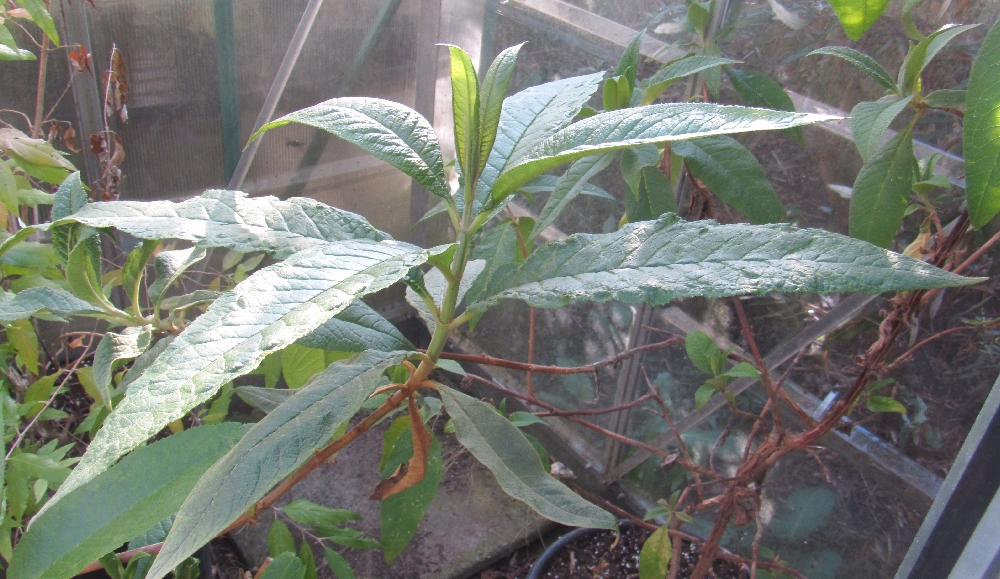
|
|
| |
Buddleja Diary for 2017 coming soon!In the meantime, here are a few antique prints to enjoy; click to enlarge. Buddleja colvilei | |
Buddleja alternifolia | |
Buddleja x intermedia | |
Buddleja japonica | |
Buddleja sessiliflora (as Buddleja verticillata) | |
|
| |
Return to the Homepage | |

